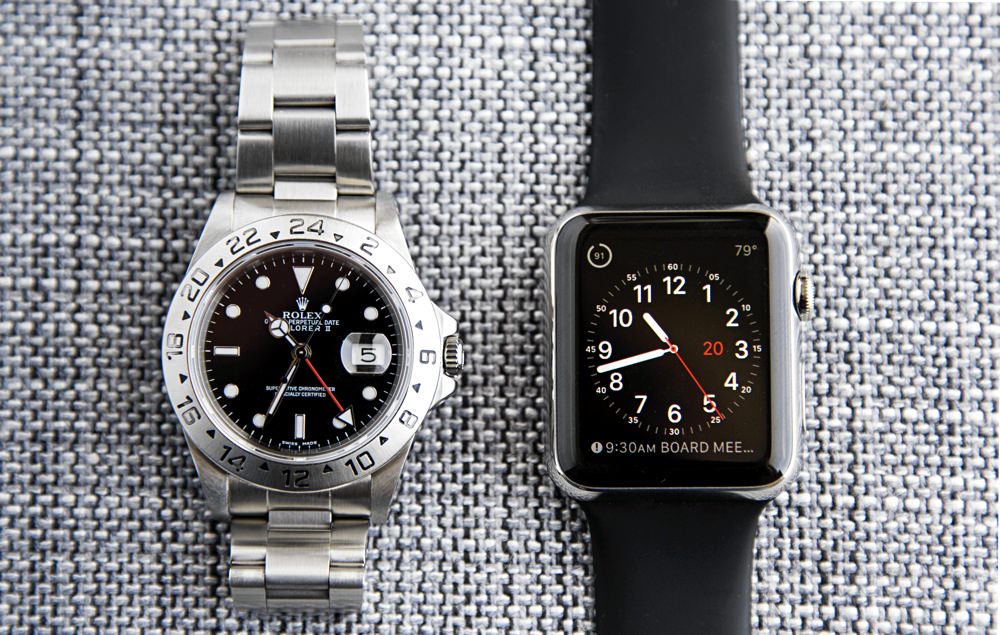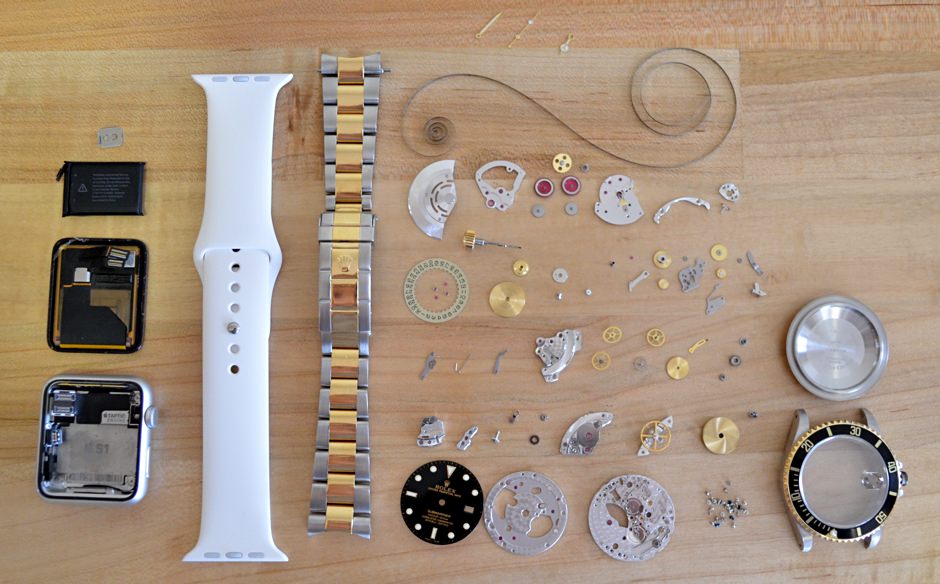7 Legendary Dive Watches
You Can Now Own
These iconic timepieces are now on sale, so get them while you can.

A vintage Rolex Explorer II ($5,000 / $4,700) and a new Apple Watch Series 3 with GPS + cellular (from $329).
Since its debut in the spring of 2015, the Apple Watch continues to have a strong presence in the tech headlines. And there are plenty of skeptics who dismiss mechanical watches and question their place in a world where numerous portable electronic devices like smartphones, tablets and laptops constantly communicate the time. But with that said, it begs the same question—why might you need an Apple Watch, which also has a lot of the same functionality? It all comes down to personal preference.
We asked our friends at Crown & Caliber to really look at an Apple Watch versus a Rolex. Every day, they see some of the best watches on the market from consigners/sellers all over the world. So we had their watchmakers completely disassemble both watches, and show us the results side-by side. The photo seems to speak for itself.

With both types of watches, there are pros and cons. A mechanical watch can perform all its functions with no battery, simply by moving your wrist or winding the crown. The Apple Watch offers an vast array of modern functions, much like a smartphone—from sending a text to tracking your daily activity. Useful functions that are not within the realm of mechanical watches, unless you count the chronograph, the pulsometer, etc. You can buy an Apple Watch for as low as $269 for an original Series 1 or up to around $1,499 for the new Ceramic Edition. Mechanical watches can range from a few hundred to hundreds of thousands of dollars.
Perhaps one of the greatest benefits of a mechanical watch, though, is the depreciation. Similar to an Apple Watch, a mechanical watch depreciates when you buy it brand new at the store. However, once a mechanical watch enters the pre-owned market, its depreciation is typically minimal, unlike that of an Apple Watch which, due to advances in technology, eventually becomes nearly worthless. We asked the valuation team at Crown & Caliber to pull some data on a Rolex Submariner 116610 from their database of sales, and here is what we found:
The biggest difference between the Apple Watch and mechanical watches may come down to their shelf life. As Apple introduces new tech, it eventually makes the current offerings obsolete, and Apple Watches will be no different. If you choose to buy an Apple Watch, you buy it knowing this— eventually, it will stop holding a charge, it will run more slowly, and Apple will stop supporting it with OS updates. Compare this to a luxury mechanical watch that could run for decades or even centuries with proper care. The tiny mechanisms—those springs, gears and motors—hold up incredibly well. They're crafted to be an heirloom that you have your whole life, and pass down to your son.
Luxury watch brands do innovate, but at a much slower pace and not to a degree that supersedes older models. That can be good for lasting style and for depreciation but not great in terms of reinvention. Take the cleverly designed straps and bracelets of the Apple Watch, for example. You won't find a traditional timepiece brand in Switzerland with the imagination to create some of those unique design features.
So, which is better, the Apple Watch or the mechanical watch? Will the Apple Watch spur the demise of the luxury watch industry as we know it? At the end of the day, it's hard to deny that the Apple Watch is a pretty cool piece of tech, but it's not an imminent threat to the luxury watch (though lower end brands are nervous for good reason). They appeal to different people with different preferences. If anything, smartwatches like the Apple Watch represent an opportunity for wrist wear to reach a newer, younger demographic and could ultimately serve as a gateway into fine timepieces. Bottom line: there's room for both the Apple Watch and mechanical watches (just maybe not on the same wrist).